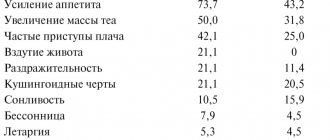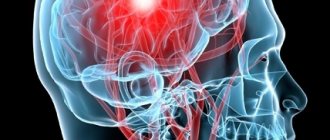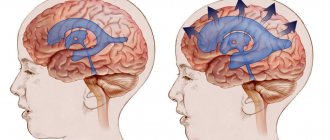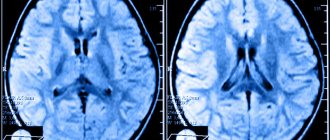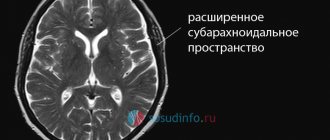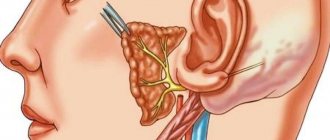Author: Soldatenkov Ilya Vitalievich
, for sindrom.info ©
Oneiroid is a psychopathology characterized by a qualitative clouding of consciousness, which is manifested by plot-related pseudohallucinations, fantastic dreams, daydreams, experiences, delusions, illusions, the appearance of unusual images and fragments, and the patient’s detachment from society. The imagination of patients reaches the level of contemplation. These phenomena in the subconscious are combined with real events and gradually replace them.
The term "oneiroid" translated from ancient Greek means "type of dreams." Oneiric syndrome was first discovered in 1894 by researchers in the field of infectious psychoses. In 1924, the pathology was described in detail by a psychiatrist from England, Mayer-Gross, who observed a patient with schizophrenia. In 1950, the Hungarian psychiatrist L. Meduna identified schizophrenia with oneiric disorder as a separate nosological entity. There have been debates and debates around this disease for a long time, significant disagreements among doctors arose, and there was no uniform terminology. Modern scientists have found that oneiric syndrome is a manifestation of various diseases: psychiatric, infectious, oncological, vascular and others.
Diseases in which oneiroid most often develops:
- Schizophrenia,
- Psychoses,
- Epilepsy,
- Traumatic brain injury,
- Alcohol and drug intoxication.
The syndrome is characterized by a staged course and is accompanied by disturbances in thought processes, speech, emotional and psychomotor state. Persons with oneiroid are characterized by ambivalence of behavior. They experience contradictory and ambivalent experiences. The simultaneous occurrence of two antagonistic feelings in patients is a sign of pathology.
Foxes with oneiroid have impaired or completely absent spatial-temporal orientation. Patients contemplate unknown things that others do not notice. Their perception of the subject changes, their own “I” is transformed by turning into an animal or an inanimate object. Participants in pseudohallucinatory situations include people around them in their fantasies.
Oneiroid is characterized by the alienation of patients from the outside world. An atypical relationship between vivid, sensual fantasies and modern realities arises in their minds. During an attack, the patient's face becomes mask-like, and their gaze becomes absent or frozen. The patients are silent and outwardly indifferent, without contact. In the post-attack period, they easily and in great detail retell their experiences and visions.
The advanced form of oneiric syndrome occurs mainly in adolescents in combination with catatonic stupor. In schoolchildren and preschool children, individual signs of pathology appear, which over time combine and form a full-fledged picture of oneiroid. In elderly people, pathology develops extremely rarely. Based on the expressed clinical picture and anamnestic data, a diagnosis is established. All patients are given pharmacological treatment taking into account the true cause of the syndrome.
Classification
There are different types of oneiroid:
- patients are completely immersed in their imagination, separating from the outside world, becoming indifferent, detached, non-contact.
Dreamlike- Fantastic-illusory - an interweaving of fantasies, dreams and illusions with events occurring in real life.
- Dream-oriented - complete immersion of patients in their dreams with the perception of objects and phenomena that do not really exist, located in subjective mental space and not having the nature of objective reality.
- Scenic-hallucinatory - the predominance of auditory, visual, tactile and other pseudohallucinations in the clinical picture.
- Alcoholic – characterized by peculiar symptoms, progresses from delirium and occurs after withdrawal of alcohol or taking a low-quality surrogate.
- Post-stroke is a complication of acute brain failure.
- Expansive - admiration of one’s personality, being in the world of fairy-tale dreams and colorful fantasies with romantic plots, friendliness, absence of danger, joy, pleasure.
- Depressive - low mood, suppression of intellectual activity, motor and volitional inhibition, suppression of instincts, difficulties in concentrating, focusing on painful experiences, low self-esteem, nightmares, constant expectation of danger, predominance of negative emotions - anxiety, fear, despondency, apathy, tearfulness .
- Manic – activation of the patient, optimistic mood, joy of life, elevated mood, mental arousal, acceleration of thinking and speech, motor excitement.
Twilight
Twilight states of consciousness are transient and heterogeneous disorders. They are characterized by intense affect, disorientation and complete amnesia during the period of stupefaction. Depending on the type of twilight, a person may also experience delusions, hallucinations, automated movements, or agitation. There are delusional, affective (dysphoric), and oriented variants of the twilight state of consciousness. There is a separate form with various ambulatory automatisms, including trance and fugue.
People around us do not always recognize the onset of a person’s twilight state of consciousness. Suspicious signs are a state of self-absorption that is inadequate to the situation, indifference to current events, stereotypic movements or ridiculous unexpected actions. Moreover, actions can be criminal, causing physical harm to other people, including murder.
Etiology
Oneiric syndrome is a nonspecific polyetiological pathology, which is a manifestation of various disorders: psychiatric diseases, severe intoxications, effects of anesthesia, viral and bacterial infections, neurological pathology, somatic non-infectious diseases, autoimmune diseases, endocrinopathies. In addition to psychogenic provocation, heredity plays a great role in the development of the disease.
- Mental illnesses – paroxysmal schizophrenia and manic-depressive psychosis.
- Exogenous intoxication caused by exposure to chemical, medicinal, narcotic and other toxic substances.
- Organic brain damage.
- Use of anesthesia during operations.
- Viral infections - cytomegalovirus, influenza and parainfluenza virus, herpes virus.
- Bacterial infection occurs in the form of sepsis, meningitis, meningoencephalitis.
- Neurological pathology - epilepsy, panic disorders against the background of acute encephalopathy, dyscirculatory disorders.
- Cardiovascular dysfunctions - stroke, myocardial infarction, heart failure, vascular dementia.
- Autoimmune disorders - rheumatism, vasculitis, SLE.
- Metabolic disorders - hypovitaminosis, pellagra.
- Endocrinopathies.
- Neoplasia leading to cachexia, chronic asthenia.
- Injuries accompanied by painful shock and blood loss.
If the cause of the pathology is exogenous intoxication - the use of psychotropic drugs, drugs, medications, the syndrome quickly progresses and has vivid symptoms. The wave-like course of oneiroid is characteristic of discirculatory phenomena and organic diseases of the brain.
Causes
Scientific research shows that the occurrence of the oneiric condition is closely related to genetic predisposition. In families where parents or close relatives have schizophrenia and other mental disorders, the risk of developing oneiroid is significantly higher.
The key factor in development is schizophrenia in a recurrent or catatonic form. Organic brain damage plays an important role: traumatic brain injuries, intracranial hematomas and neoplasms of any nature. Long-term use of drugs that affect the central nervous system and epilepsy increase the risk of oneiric condition.
The cause of the development of oneiroid is considered not only schizophrenia, but also other factors:
- intoxication with alcoholic beverages, narcotic drugs, as well as substances used for drug intoxication: acetone, glue, etc.;
- severe viral or bacterial infection, accompanied by fever and intoxication;
- inflammatory damage to the brain in the form of encephalitis, meningitis is also a risk factor, due to the possibility of inflammation spreading to nervous tissue;
- epilepsy with the development of psychosis; in addition, long-term use of anticonvulsants and organic changes as a result of epileptic seizures increase the risk of disturbances of consciousness;
- metabolic disorders in the body with the development of endogenous intoxication (a similar condition accompanies liver and kidney failure).
One patient may have several of these causes. Oneiric clouding of consciousness is detected in people of different ages. In the case of children, the disease is closely related to heredity. Moreover, their clinical picture intensifies as they grow older.
Symptoms
Oneiric stupefaction develops in five stages, each of which has specific clinical symptoms. The stages have very blurry outlines and smoothly flow into each other.
- Initial stage: unstable mood - increased or decreased, sleep disturbances - insomnia or colorful dreams, neurovegetative signs - cardialgia, impotence, cephalgia, loss of appetite, hyperhidrosis, facial flushing. Patients suffer from fear of insanity.
- The stage of the appearance of delusional ideas - delusions of death, incurable illness or persecution are often combined with hallucinosis, illusory ideas, increased tension, paranoia, disorder of thinking processes, expressed in incorrect perception of the surrounding world.
- The stage of emotionally charged delirium of staging, during which patients develop derealization and depersonalization, illusions and mental automatisms appear. The surrounding objects change externally, and faces also internally. Living people are replaced by doubles, faces and characters are transformed. Patients consider themselves heroes of myths and works of art, aliens and strangers.
- Paraphrenia with fantastic or megalomanic delusions is a stage of pathology in which patients become the center of the Universe. They communicate with angels and demons, are in the midst of the struggle between good and evil, and consider themselves significant and great. In their subconscious, terrible hallucinations arise about disasters, mass deaths, and the end of the world. Often a person does not realize where he is, gets lost in time and space, and becomes dangerous to others.
- The stage of expanded oneiroid - the world of dreams and fantasies exceeds real life. Patients participate in their own pseudo-hallucinations, they are immersed in fairy-tale scenes and implausible plots. They actively fight the otherworldly world of spirits and become participants in global disasters. The patient subconsciously goes through all stages of the development of pathology: from the spectator and the main character to the victim of the unfolding events. This is the climax of the attack. Clinical signs of this stage are disorientation, confusion, and illusory-hallucinatory fantasies. Patients become self-absorbed and stop contacting others. With total pseudohallucinosis, painful experiences overtake a person who no longer perceives real events. During an attack, patients become numb, do not make contact, their gaze is fixed at one point.
- The reverse development of pathology, in which patients clearly remember and colorfully describe their painful experiences.
Main clinical manifestations of the syndrome
Emotional stress is the first manifestation of the syndrome. The lability of emotions, their changes in a negative or positive direction lead to sleep disorders, manifested by insomnia or vivid dreams. Constant fear drives patients crazy. Signs of manic oneiroid are that patients are hyperactive, they admire and are touched, they perceive current events favorably and joyfully. Depressive oneiroid is manifested by apathy, anxiety, irritation, and asthenia. Patients often experience changeable feelings: from lethargy, lack of initiative, frustration to excessive ambition and soulfulness.
Disorders of mental and speech functions are manifested by delirium, dual orientation, and disturbed sequence of thoughts. A delusional mood is manifested by unsystematized delusions of persecution, death, and hypochondria. The delusion of staging is accompanied by verbal illusory-hallucinatory phenomena, transformation of images and objects, a feeling of alienation, unnaturalness, “made-up” of one’s own movements, acceleration or deceleration of speech. The paraphrenic stage is a fantastic retrospective and Manichaean delirium with preservation of self-awareness. Patients tell how they saw a staircase in a large hall, along which angels descended and demons ascended. They first become witnesses to a grandiose battle, and as the pathology develops, they become participants in the events. The self-awareness of patients is gradually impaired. They are completely immersed in pseudo-hallucinations. Verbal contact with patients is impossible because they speak slowly and slurred.
A disorder of the volitional sphere is a sign of a developed pathology. Patients rarely experience psychomotor agitation. Usually they experience numbness and detachment, their facial expressions are monotonous and “frozen.” Phenomena of catatonia are possible - stupor or hyperactivity, absent-mindedness and inability to concentrate on a specific object, amnestic symptoms - remembering and accurately reproducing painful experiences with loss of memory for real events.
Hallucinations - patients travel between planets, communicate with Martians, go to the Moon and perform a certain mission there; on the streets of the city they organize uprisings, lead naval battles, fight with pirates, experience the end of the world, become sites of destructive actions - cities perish under their leadership, millions of people die, volcanoes erupt, earthquakes occur, planets collide. Fantasies become more and more colorful and fabulous. The patient answers questions evasively, speaks in short phrases, often incomprehensible to the interlocutor, he is confused and indistinctly addresses himself mostly to himself. At the same time, facial expressions are not thematic or are completely absent. Gradually he goes into the world of dreams and falls into his dreamlike state, not noticing the real dangers. After emerging from oneiroid, patients remain convinced of the truth of their visions for a long time.
Oneiroid - what is it?
The pathology in question is expressed in a qualitative disorder of consciousness. Oneiroid is also a dream disorder in psychology, and can also be called a dream-like disorder.
Oneiroid is characterized by the absolute detachment of patients from the environment, a change in the Self up to its reincarnation. Their experiences have a fantastic content, they are rarely ordinary, unfolding in the form of alternating unreal scenes.
Oneiroid cannot be classified as a disease-specific syndrome. Its etiology is due to both exogenous factors and endogenous causes. We can speak of an endogenous nature in the absence of intoxication and signs of any clinically important organ dysfunction.
Oneiric type clouding of consciousness is like a waking dream. It manifests itself as a clouding of consciousness coupled with an influx of involuntarily arising ideas of fantastic content. Patient's figurative representations always have an internal projection. In other words, with oneiroid there is a prevalence of pseudohallucinatory phenomena, unusually colorful and unusual, which distinguishes it from delirium. The surrounding environment is perceived as specially arranged, as if a “play” is being played out.
In addition, spatiotemporal disorientation is noted. So, for example, the patient realizes that he is in a medical institution and at the same time considers himself the commander of a spaceship crossing the galactic expanses, and he perceives the surrounding medical staff and other patients as fellow astronauts.
What is oneiric syndrome? The behavior of a patient in oneiric clouding of consciousness contrasts with his unreal pseudohallucinatory symptoms. The patient usually lies motionless, eyes closed, sometimes making smooth “flying” movements with his hands, watching his own adventures, as if from the sidelines. There is also a violation of awareness of one's own age and perception of time. An individual may feel as if he has been in flight for several years. Sometimes an individual suffering from oneiroid may wander around smiling thoughtfully. At the same time, sometimes the patient, upon persistent questioning, can tell some of his fantastic pictures of the imagination.
Upon recovery from the state of oneiric attack, the individual retains the memories of his own fantastic ideas, and the actual events occurring during this attack, on the contrary, are forgotten.
Diagnostic measures
Diagnosis of the oneiric state is quite complex. Sometimes patients do not have any complaints, except for an increase in internal tension, inhibited reaction, insomnia, and depression. These manifestations are nonspecific. They do not allow one to suspect this disorder. Psychiatrists talk with the patient and his relatives, collect a life history, and observe manners and behavior. All this data is extremely important for making a diagnosis. In addition, a comprehensive analysis of somatic and neurological status is required. The results of laboratory and instrumental diagnostics are often decisive.
- Patients need to donate blood for general clinical and biochemical tests, cerebrospinal fluid for cytological, histological and microbiological studies.
- Instrumental diagnostic methods - tomographic and x-ray examinations of the skull.
- The psychological state of the patient is determined using special tests and scales.
Diagnosis, treatment
The diagnosis is made on the basis of complaints, medical history, results of clinical observations, and interviews with close relatives.
The differential diagnosis is carried out with onirism, which develops in severe infectious diseases, which is accompanied by excitement, dreams, perceived by patients as reality.
No specific therapy for oneiric syndrome has been developed. Treatment is aimed at relieving etiological factors.
- In case of poisoning, detoxification is prescribed, in case of brain infections - antibiotics, anti-inflammatory drugs, in cases of impaired blood circulation in the head, vascular drugs are used, in case of tumors, surgical manipulations are performed.
- Nonspecific drugs include antipsychotics, antidepressants, nootropics, and tranquilizers.
- During the rehabilitation period, physiotherapy, massage, physical therapy, and reflexology can be used.
Prevention of the development of the syndrome consists of timely adequate treatment of somatic and psychiatric diseases and maintaining a healthy lifestyle.
Gasanova Sabina Pavlovna
Healing procedures
Patients with oneiric syndrome are treated in a psychiatric clinic under the supervision of medical personnel. The treatment regimen is drawn up by a psychiatrist taking into account the cause of the pathology.
General therapeutic measures include:
- Detoxification – intravenous administration of saline solutions, glucose, “Reopoliglucin”, oral administration of “Rehydron”, “Atoxil”, “Enterol”,
- Diuretics - Mannitol, Lasix,
- Neuroleptics - “Azaleptin”, “Haloperidol”, “Aminosin”, “Tizercin”,
- Antidepressants - Prozac, Coaxil, Amitriptyline,
- Sedatives – “Afobazol”, “Persen”, “Novopassit”,
- Nootropic drugs – “Pantogam”, “Semax”, “Piracetam”,
- Cytoprotectors – “Actovegin”, “Riboxin”, “Trimetazidine”,
- Antioxidants – “Mexidol”, “Glutamic acid”, “Glycine”,
- Vascular drugs – “Trental”, “Vinpocetine”, “Cinnarizine”,
- Neuroprotectors - Phezam, Thiocetam,
- Tranquilizers – “Sibazon”, “Relanium”,
- Antispasmodics – “Papaverine”, “Drotaverine”, “Spazmalgon”,
- Broad spectrum antibiotics for infectious diseases,
- Electroconvulsive therapy is performed in severe cases.
With severe psychomotor agitation, patients require physical restraint. However, in most cases, calming psychotherapy is sufficient.
The prognosis of oneiroid is determined by the course of the underlying disease. After quality psychiatric treatment, patients may require consultation with specialists.
Diagnostics
To make a diagnosis, the doctor gets acquainted with the description of the patient’s condition and also studies the features of clinical manifestations. In the process of carrying out diagnostic measures, it is necessary to differentiate oneiric syndrome from oneirism. The latter is characterized by the patient's confusion regarding real events and dreams immediately after awakening. Also, a patient with onirism can see dreams while awake, simply by closing his eyes, without falling asleep in the traditional sense of the essence of this process.
Oneirism develops as a result of severe burns of the body, various infectious lesions and severe injuries. Unlike the pathology studied today, it is not accompanied by true hallucinations. At the same time, a patient with oneirism can be aware of the fact of the presence of dream experiences, while patients with oneiroid, as noted, do not see the difference between reality and hallucinations.
Diseases characterized by the syndrome
The development of oneiric syndrome is possible with:
- Exogenous-organic form: with infectious (encephalitis), intoxication and other somatogenic psychoses, presenile and senile psychoses (see F03. - unspecified dementia
(more often with the so-called Kraepelin's disease - F03.33)), vascular dementia, traumatic brain injury (traumatic brain injury - TBI), epilepsy, delirium delirium. A feature of oneiroid in acute intoxication (for example, inhalation of Moment glue for the purpose of drug intoxication) is its lightning-fast development, sometimes within several minutes. With other exogenous-organic diseases, it also begins and ends relatively quickly. A feature of oneiroid in alcoholic delirium, somatogenic and vascular psychoses and psychoses in TBI in the early stages of development is pronounced asthenia, followed by delirium or stunning. With TBI and epilepsy, asthenia can turn into twilight stupefaction. In Kraepelin's disease, agitated-anxious depression occurs before full-blown oneiroid. With all of the above disorders, oneiric syndrome develops without a classical pattern; it is characterized by confusion with the symptoms of these diseases (in alcoholic delirium - zooptic hallucinations, motor agitation). Self-awareness disorders do not occur. There are no symptoms of catatonia. Oneiroid may end with transitional symptoms of Wicca. Oneiric syndrome in exogenous organic diseases is evidence of a severe course of the disease, and its transition to amentia or stunning is an even more unfavorable sign. - Endogenous - in schizophrenia, less often in bipolar affective disorder. In ICD-9 there was a category 295.24 - Oneiric catatonia as a variant of fur-like schizophrenia
and 295.25 -
Oneiric catatonia as a variant of periodic schizophrenia
.
They now belong to F20.2 - Catatonic schizophrenia
. In paranoid schizophrenia, oneiric syndrome can be combined with Kandinsky-Clerambault syndrome (mental automatism syndrome).
In children
In children 3-7 years old, initial manifestations of oneiroid (preoneiroid) are most often observed: motor restlessness, confusion, anxiety, fears, episodic visual and auditory illusions, phenomena of false recognition - a strange woman may seem like a mother or nanny to the child. In such cases, orientation is not yet disrupted.
Symptoms of oneiric syndrome in younger children are rudimentary, fragmentary, and difficult to determine due to the limited ability to self-report and describe painful experiences.
In older schoolchildren, the syndrome may manifest itself fragmentarily and for a short period of time.
Causes
Scientific research shows that the occurrence of the oneiric condition is closely related to genetic predisposition. In families where parents or close relatives have schizophrenia and other mental disorders, the risk of developing oneiroid is significantly higher.
The key factor in development is schizophrenia in a recurrent or catatonic form. Organic brain damage plays an important role: traumatic brain injuries, intracranial hematomas and neoplasms of any nature. Long-term use of drugs that affect the central nervous system and epilepsy increase the risk of oneiric condition.
The cause of the development of oneiroid is considered not only schizophrenia, but also other factors:
- intoxication with alcoholic beverages, narcotic drugs, as well as substances used for drug intoxication: acetone, glue, etc.;
- severe viral or bacterial infection, accompanied by fever and intoxication;
- inflammatory damage to the brain in the form of encephalitis, meningitis is also a risk factor, due to the possibility of inflammation spreading to nervous tissue;
- epilepsy with the development of psychosis; in addition, long-term use of anticonvulsants and organic changes as a result of epileptic seizures increase the risk of disturbances of consciousness;
- metabolic disorders in the body with the development of endogenous intoxication (a similar condition accompanies liver and kidney failure).
One patient may have several of these causes. Oneiric clouding of consciousness is detected in people of different ages. In the case of children, the disease is closely related to heredity. Moreover, their clinical picture intensifies as they grow older.
Treatment and prevention
In the absence of adequate treatment, the patient may not get out of the oneiric state on his own. In most cases, hospitalization of the patient in a psychiatric department of a hospital is indicated.
The doctor will determine the treatment regimen based on the causes and stage of the disease. For vascular lesions and infectious diseases, treatment of the underlying disease is mandatory. Oneiroid of alcoholic, toxic origin is treated somewhat differently than other types.
The doctor may prescribe the following medications to the patient:
- Neuroleptics (azaleptin, carbidine, haloperidol, trisedil, aminosine and others);
- electroconvulsive therapy (in severe cases);
- nootropic drugs (aminalon, acephan, pantogam);
- antipsychotics;
- for depressive symptoms - pyriditope.
If oneiric syndrome develops after a stroke, it is treated with antipsychotic drugs, then vascular drugs are prescribed: troxovasin, bilobil, ginkgo biloba and others.
Treatment of exogenous oneiroid is reminiscent of the treatment of delirium (delirium tremens) in alcoholics. Patients are prescribed:
- Tranvilizers (sibazon, relanium);
- sleeping pills (sodium hydroxybutyrate, ridazine);
- means for removing toxins (cytoflavin, L-lysine, sodium thiosulfate, Atoxil); Korglykon, soda solution, strophanthin, cordiamine, papaverine, platifilin, polyglucin, dibazol can also be used;
- decongestants (mannitol, Lasix) to prevent brain swelling.
It should be noted that a favorable prognosis most often concerns oineroid syndrome due to poisoning and organic diseases. If a person has schizophrenia, other mental disturbances and personality disorders, then everything depends on the severity of the pathology.
To prevent oneiroid, you must follow a few simple rules. The main thing is not to drink, not to use drugs, and to avoid ingestion and direct contact with other toxic substances. If a person has already had cases of alcoholic oneiroid, then after recovery he urgently needs to get rid of bad habits!
General information
Oneiroid is a psychopathological syndrome in which a qualitative disturbance and clouding of consciousness of a special type occurs, reminiscent of dream-like disorientation.
With oneiric syndrome, fantastic pictures unfold in a person’s head, dreamlike and pseudo-hallucinatory experiences arise, which can intertwine with reality or completely replace it. A state of disorientation in space and time, clouding of consciousness, and passivity are usually caused by the participation of patients in their pseudohallucinatory situations. This is not amentia since it is a constant fruitless search for orientation and not stupefaction , which is characterized by a lack of orientation. In addition, people nearby can become participants in the situations experienced by oneiroid, so the symptoms often resemble a delirious state .
The main symptom of this pathopsychological condition is disorientation in one’s own personality, its duality, a complete change in perception, transformation of one’s own “I” can go as far as turning into a bird, a plant or even an inanimate object.
Oneiric syndrome usually manifests in adolescents and has features of catatonic stupor. For older people, oneiric delusional experiences are not typical.
Brief historical background
In 1894, E. Regis called the state of psychosis caused by infections and intoxications oneiric delirium, but in 1909 the French psychiatrist G.G. de Clerambault was proposed to call this syndrome oneiric delirium. 15 years later, V. Mayer-Gross published a book in which he described the state of confusion and forms of oneiric experience in patients suffering from psychosis, which is now considered recurrent schizophrenia , which is the most complete form of the disease, occurring in several successive stages.
The term comes from the ancient Greek words oneiros - dream and eidos - view.


